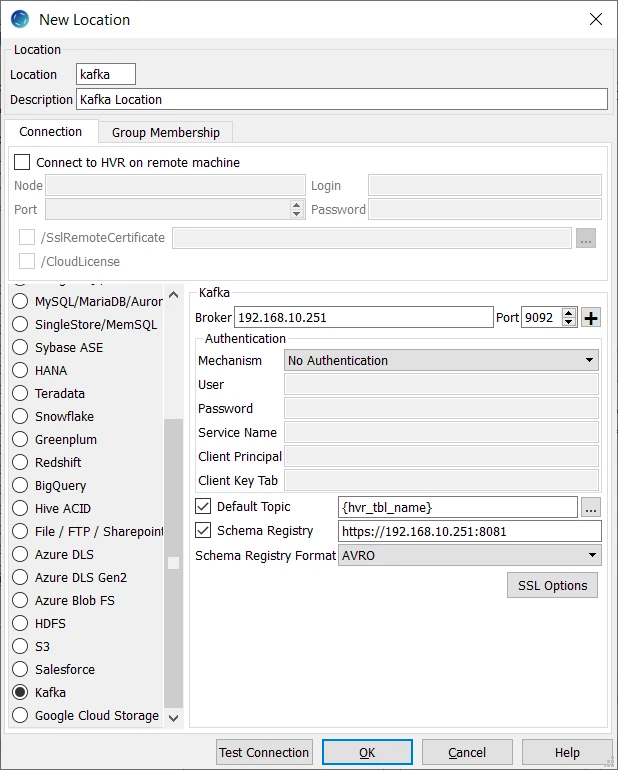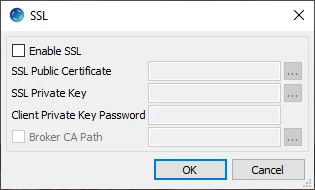Requirements for Kafka
| Capture | Hub | Integrate |
|---|---|---|
This section describes the requirements, access privileges, and other features of HVR when using Kafka for replication. For information about compatibility and supported versions of Kafka with HVR platforms, Platform Compatibility Matrix.
For the Capabilities supported by HVR on Kafka, see Capabilities for Kafka.
For instructions to quickly setup replication into Kafka, see Quick Start for HVR - Kafka.
Installation Dependencies
On Linux, to use either of the Kafka authentication Mechanism - User Name and Password or Kerberos (see Location Connection below), HVR requires the library libsasl2.so.2 to be installed. This library is part of Cyrus SASL and can be installed as follows:
yum install cyrus-sasl
zypper install cyrus-sasl
There are no special requirements for installing Kafka on Windows.
Location Connection
This section lists and describes the connection details required for creating Kafka location in HVR. HVR uses librdkafka (C library which talks Kafka's protocol) to connect to Kafka.

| Field | Description |
|---|---|
| Broker | The hostname or IP address of the Kafka broker server. Example: pkc_lgwgm.eastus2.azure.confluent.cloud |
| Port | The TCP port that the Kafka server uses to listen for client connections. The default port is 9092. HVR supports connecting to more than one Kafka broker servers. Click ➕ to add more Kafka brokers. |
| Mechanism | The authentication mode for connecting HVR to Kafka server (Broker). Available options:
On Linux, to use User Name and Password or Kerberos, HVR requires the libsasl2.so.2 library to be installed. For more information, see Installation Dependencies. When connecting to Kafka clusters in Confluent Cloud, set the authentication mode to User Name and Password. |
| User | The username to connect HVR to Kafka server. |
| Password | The password of the User to connect HVR to Kafka server. |
| Service Name | The Kerberos Service Principal Name (SPN) of the Kafka server. This field is enabled only if Mechanism is Kerberos. |
| Client Principal | The full Kerberos principal of the client connecting to the Kafka server. This is required only on Linux. This field is enabled only if Mechanism is Kerberos. |
| Client Key Tab | The directory path where the Kerberos keytab file containing key for Client Principal is located. This field is enabled only if Mechanism is Kerberos. |
| Default Topic | The Kafka topic to which the messages are written. Example: {hvr_tbl_name}_avro |
| Schema Registry | The URL (http:// or https://) of the schema registry to use Confluent compatible messages. Example: http://192.168.10.251:8081 If the basic authentication is configured for the schema registry, then the login credentials (username and password) must be specified in the URL. The format is http[s]://user:password@schemaregistry_url:port Example: https://myuser:mypassword@abcd-efgh.eu-central-1.aws.confluent.cloud |
| Schema Registry Format | The Kafka message format. Available options:
|
| SSL Options | Show SSL Options. |
SSL Options

| Field | Description |
|---|---|
| Enable SSL | Enable/disable (one way) SSL. If enabled, HVR authenticates the Kafka server by validating the SSL certificate shared by the Kafka server. |
| SSL Public Certificate | The directory path where the .pem file containing the client's SSL public certificate is located.
|
| SSL Private Key | The directory path where the .pem file containing the client's SSL private key is located. |
| Client Private Key Password | The password of the private key file that is specified in SSL Private Key. |
| Broker CA Path | The directory path where the file containing the Kafka broker's self-signed CA certificate
is located. Broker CA is used when connecting to Kafka brokers hosted on nodes
(like Confluent Cloud or in-house installation ) that use their own CA not included
in a standard bundle. For example, for MS Azure Event Hub, this parameter is not required. HVR supplies the CA in $HVR_HOME/lib/cert/ca-bundle.crt. |
Integrate and Refresh Target
HVR allows you to Integrate or Refresh changes into Kafka as a target location. HVR uses librdkafka to send data packages into Kafka message bus during Integrate (continuous) and Refresh (bulk).
This section describes the configuration requirements for integrating changes (using Integrate and HVR Refresh) into Kafka location. For the list of supported Kafka versions, into which HVR can integrate changes, see Integrate changes into location in Capabilities.
Kafka Message Format
HVR's Kafka location sends messages in the JSON format by default using mode SCHEMA_PAYLOAD (see FileFormat /JsonMode), unless the location connection option Schema Registry Format is used, in which case each message uses the compact AVRO-based format (Schema Registry Format - Avro) or the JSON file format using mode ROW_FRAGMETS (Schema Registry Format - JSON).
- Schema Registry Format - Avro: This is not a true AVRO because each message would not be a valid AVRO file (e.g. no file header). Rather, each message is a 'micro AVRO' containing fragments of data encoded using AVRO data type serialization format.
- Schema Registry Format - JSON: Schema is encoded according to the JSON schema specification.
- All Formats: the JSON format (using mode SCHEMA_PAYLOAD, see FileFormat /JsonMode), the 'micro AVRO' format, and the JSON schema encoding (starting from Confluent Platform 5.5.0) conform to the Confluent's 'Kafka Connect' message format standard and can be used with any implementation of Kafka sink connectors. When Kafka location is configured with option Schema Registry Format (see section Location Connection above), action FileFormat with parameters /Xml, /Csv, /AvroCompression or /Parquet cannot be used.
Backward compatibility: The Avro format (default for the Schema Registry Format location connection option) is compatible with any Confluent platform below 5.5.0.
If you want to use the Cloudera Schema Registry Format, you must use it in the Confluent compatible mode. This can be achieved by indicating the URL in the following format: http://FQDN:PORT/api/v1/confluent, where FQDN:PORT is the address of the Cloudera Schema Registry specified in the Schema Registry Format field when configuring the location (see section Location Connection above).
Action FileFormat with parameters /Xml, /Csv, /Avro or /Parquet can be used to send messages in other formats. If parameter /Avro is chosen without enabling location connection option Schema Registry Format, then each message would be a valid AVRO file (including a header with the schema and column information), rather than the Kafka Connect's compact AVRO-based format.
The Kafka messages should also contain special columns containing the operation type (delete, insert and update) and the sequence number. For achieving this, define action ColumnProperties for the Kafka location as mentioned below:
| Group | Table | Action |
|---|---|---|
| KAFKA | * | ColumnProperties /Name=op_val /Extra /Datatype=integer /IntegrateExpression="{hvr_op}" |
| KAFKA | * | ColumnProperties/Name=integ_seq /Extra /Datatype=varchar /Length=36 /IntegrateExpression="{hvr_integ_seq}" /TimeKey |
Metadata for Messages
To process HVR's messages, a Kafka consumer will often need metadata (table and column names, data types etc) about the replicated table. If location connection option Schema Registry Format is set, then it can read this from that registry. For JSON format with the default mode (SCHEMA_PAYLOAD), each message contains this information. Another way to include metadata to each message is to add actions ColumnProperties /Extra /IntegrateExpression to add values like {hvr_tbl_name} and {hvr_op}.
Kafka Message Bundling and Size
By default, each Kafka message contains just one row, regardless of the format chosen. Multiple rows can be bundled into a single message using Integrate /MessageBundling with either of the following bundling modes:
- CHANGE: update message contains both 'before' and 'after' rows, inserts and deletes just contain one row
- TRANSACTION: message contains all rows associated with a captured transaction
- THRESHOLD: message is filled with rows until it reaches limit. Bundled messages simply consist of the contents of several single-row messages concatenated together.
For more information on bundling modes, see parameter /MessageBundling of action Integrate.
Although bundling of multiple rows can be combined with the Kafka Connect compatible formats (JSON with default mode SCHEMA_PAYLOAD), the resulting (longer) messages no longer conform to Confluent's 'Kafka Connect' standard.
For bundling modes TRANSACTION and THRESHOLD, the number of rows in each message is affected by action Integrate /MessageBundlingThreshold (default is 800,000). For those bundling modes, rows continue to be bundled into the same message until after this threshold is exceeded. After that happens, the message is sent and new rows are bundled into the next message.
Parameter /MessageBundlingThreshold has no effect on the bundling modes ROW or CHANGE.
By default, the minimum size of a Kafka message sent by HVR is 4096 bytes; the maximum size of a Kafka message is 1,000,000 bytes; HVR will not send a message exceeding this size and will instead give a fatal error; if Integrate /MessageCompress parameter is used, this error will be raised by a Kafka broker. You can change the maximum Kafka message size that HVR will send by defining $HVR_KAFKA_MSG_MAX_BYTES, but ensure not to exceed the maximum message size configured in Kafka broker (settings message.max.bytes). If the message size exceeds this limit then the message will be lost.
HVR_KAFKA_MSG_MAX_BYTES works in two ways:
- checks the size of a particular message and raises an HVR error if the size is exceeded even before transmitting it to a Kafka broker.
- checks the maximum size of compressed messages inside the Kafka transport protocol.
If the message is too big to be sent because it contains multiple rows, then less bundling (e.g. /MessageBundling=ROW) or using a lower MessageBundlingThreshold can help reducing the number of rows in each message. Otherwise, the number of bytes used for each row must be lowered; either with a more compact message format or even by actually truncating a column value (by adding action ColumnProperties /TrimDatatype to the capture location).
HVR does not recommend to use parameters /Compress or /AvroCompression of action FileFormat with Kafka location (even if the location connection option Schema Registry Format is not set). Instead, use parameter /MessageCompress of action Integrate.
Syncing Kafka, Interruption of Message Sending, and Consuming Messages with Idempotence
An HVR integrate job performs a sync of messages sent into Kafka at the end of each integrate cycle, instead of after each individual message. This means if the job is interrupted while it is sending messages, and when it is restarted, the sending of multiple rows from the interrupted cycle may be repeated. Programs consuming Kafka messages must be able to cope with this repetition; this is called being 'idempotent'. One technique to be idempotent is to track an increasing sequence in each message and use detect which messages have already been processed. A column with such an increasing sequence can be defined using action ColumnProperties /Name=integ_key /Extra /Datatype=varchar /Length=32 /IntegrateExpression="{hvr_integ_seq}". If HVR resends a message, its contents will be identical each time, including this sequence number.
Kafka Message Keys and Partitioning
Kafka messages can contain a 'key' which Kafka uses to put messages into partitions, so consuming can be parallelized. HVR typically puts a key into each message which contains a hash computed from values in the 'distribution key' column of each row. This key is present only if the messages are in JSON or AVRO format. It is not present when the message bundling (/MessageBundling) mode is TRANSACTION or THRESHOLD.
Known Issue
When using Kafka broker version 0.9.0.0 or 0.9.0.1, an existing bug (KAFKA-3547) in Kafka causes timeout error in HVR.
The workaround to resolve this issue is to define action Environment for the Kafka location as mentioned below:
| Group | Table | Action |
|---|---|---|
| KAFKA | * | Environment/Name=HVR_KAFKA_BROKER_VERSION/Value=0.9.0.1 |
If the Kafka broker version used is 0.9.0.0 then /Value=0.9.0.0